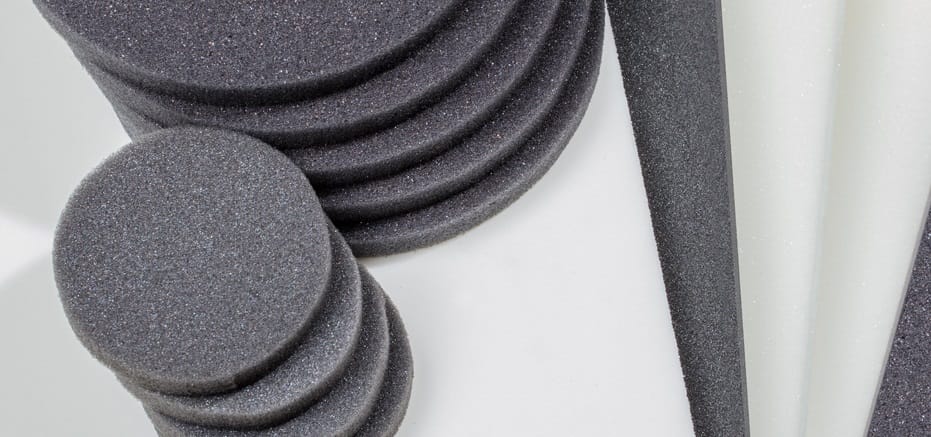Foams
Foams are made by trapping pockets of gas within a material. Foams are usually made from polymers, but they can also be made from ceramics or metals. In open cell foams, the pockets are interconnected and filled with air. Open cell foams can be compressed easily because the air can flow freely through the pockets. For closed cell foams, the gas pockets are not connected. Instead, each pocket is completely surrounded with solid material. Because the gas is trapped within the pockets, closed cell foams do not compress as easily as open cell foams. All types of foam can be processed by laser cutting, engraving, and marking.
Types of Foam
- BISCO® Silicone
- Ceramic Foam
- EVA Foam
- Metal Foam
- Neoprene™ Foam
- PET Foam
- Polyethylene Foam
- Polyisocyanurate Foam
- Polyurethane Foam
- PORON® Foam
- Silicone Foam
- Styrofoam™
Types of Laser Processes
Lasers are playing an ever expanding role in material processing, from new product development to high volume manufacturing. For all laser processes, the energy of a laser beam interacts with a material to transform it in some way. Each transformation (or laser process) is controlled by precisely regulating the wavelength, power, duty cycle and repetition rate of the laser beam. These laser processes include the following:All materials have unique characteristics that dictate how the laser beam interacts and consequently modifies the material. The most common processes for foams are the following:
Laser Cutting of Foam
Polymer based foam can be cut most effectively using a CO2 laser. The laser beam heats the material directly in its path, causing it to vaporize. If the laser power is sufficiently high, the laser beam will cut completely through the material. Polymers vaporize quickly when cut with a laser beam, resulting in smooth edges with minimal heat affected zone. For metal based foams, a Fiber laser is most effective. The Fiber laser can cut through thin sheets of foam (up to 1/8” or 3 mm). Ceramic based foam is not usually cut with a laser because it is very brittle and can crack.
Laser Engraving of Foam
The power of the laser beam can be limited so that it removes material (engraves) to a specified depth. A CO2 laser is best for laser engraving polymer foams, while a Fiber laser is best for metal foams. The laser engraving process can be used to create patterns and designs in the foam surface. Laser engraving can also be used to convey information.
Laser Marking of Foam
Metal and ceramic foams can be laser marked using a Fiber laser. The energy of the Fiber laser beam is absorbed by the surface of the material, causing it to heat up and change color or hue. This change in appearance creates a visible mark without removing material. Laser marking can be used to create designs or to convey information.
Combined Process
The laser cutting, engraving, and marking processes described above can be combined without having to move or re-fixture the foam.
General Foam Laser System Considerations
Platform Size – Must be large enough to hold the largest sheets of foam that will be laser processed or be equipped with Class 4 capability and safety precautions for processing larger sheets.
Wavelength – The 10.6 micron wavelength is the best choice for laser cutting and engraving polymer foams. The 1.06 micron wavelength is the best choice of cutting, engraving, and marking metal foam. The 1.06 micron wavelength is also the base choice for laser marking ceramic foams.
Laser Power – Must be selected based on the processes that will be performed. 25 to 150 Watts (CO2 laser) is best for polymer foam laser processing. A 40 to 50 Watts Fiber laser is best for metal or ceramic foam laser processing.
Lens – A 2.0 lens is the best general process lens for foam laser material processing.
Cutting Table – Supports sheets of foam for laser cutting.
Exhaust – Must have sufficient flow to remove the gasses and particles that are generated during laser process from the foam laser engraving, cutting, and marking equipment.
Air Assist – Provides a jet of air near the focal point of the laser to help remove gasses and particles that are generated during foam laser engraving, cutting, and marking.
Environmental, Health and Safety Considerations for Foam Laser Material Processing
Laser-material interactions almost always create gaseous effluent and/or particles. The effluent from foam laser processing will include various volatile organic compounds (VOCs) and should be routed to an exterior environment. Alternatively it may be treated with a filtration system first and then routed to an exterior environment. Foam combustion is inherent to laser processing and may produce flames. Therefore foam laser material processing should always be supervised.

